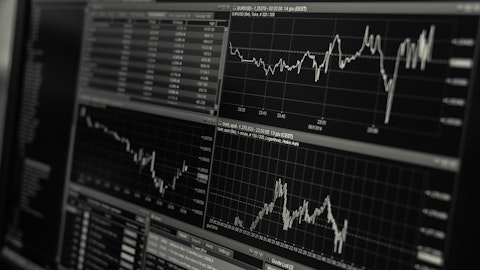Exxon Mobil Corporation (NYSE:XOM) Q4 2023 Earnings Call Transcript February 2, 2024
Exxon Mobil Corporation isn’t one of the 30 most popular stocks among hedge funds at the end of the third quarter (see the details here).
Operator: Good morning, everyone, and welcome to the Exxon Mobil Corporation’s Fourth Quarter 2023 Earnings Webcast. Today’s call is being recorded. I would now like to turn the call over to Ms. Jennifer Driscoll. Please go ahead, ma’am.
Jennifer Driscoll: Good morning, everyone. Welcome to ExxonMobil’s fourth quarter 2023 earnings call. We appreciate you joining the call today. I’m Jennifer Driscoll, Vice President of Investor Relations. I’m joined today by Darren Woods, Chairman and CEO, and Kathy Mikells, Senior Vice President and CFO. This presentation and pre-recorded remarks are available on the Investors section of our website. They are meant to accompany the fourth quarter earnings news release, which is posted in the same location. Shortly, Darren will give you an overview of our 2023 performance. Then, we will take your questions. In conjunction with our recent announcement about acquiring Pioneer Natural Resources, we’ve included additional information about the transaction on Slide 2.
Please be aware that this presentation is not intended to be a solicitation of any vote or approval. During today’s call, we’ll make forward-looking statements, which are subject to risks and uncertainties. Please refer to our cautionary statement on Slide 3. You can find more information on the risks and uncertainties that apply to any forward-looking statements in our SEC filings on our website. Note that we also provided supplemental information at the end of our earnings slides, including an overview of full-year results, which are posted on the website. And now, I’ll turn it over to Darren.
Darren Woods: Good morning, and thanks for joining us. I want to start with the theme of the quarter, which frankly, has been a theme of the year, excellence in execution. Whether it’s operating our facilities, building projects, deploying technologies, trading, marketing, sales, supply chain, or any of our other activities, the men and women of ExxonMobil are setting and holding themselves to very high standards as they execute their responsibilities. Their hard work and commitment drove the strong results we reported today and are the foundation of our success. At the end of the day, it’s all about our people. They make the difference and are delivering industry-leading results. And nothing is more important than the safety of our people.
Keeping them safe requires intense focus and relentless discipline, 24 hours a day, every single day. For many years we’ve outperformed industry benchmarks for workplace safety. Over the last several years we’ve been implementing improved systems for managing both personnel and process safety, leveraging best practices from across our company and industry, our own and others. These efforts are paying off with continued improvements in the number and severity of incidents. The discipline needed to consistently deliver industry-leading safety performance manifests itself in all our work. We see it in our project teams, who are delivering large capital projects at top-quintile performance on cost and schedule. We see it in the reliability of our operations, where we achieved record performance in both the upstream and refining.
We see it in our environmental performance, where we set several new records. And we see it in the successful management of the transformational re-organizations we’ve made over the last several years. Results are clear. By any measure, 2023 was an outstanding year. We delivered $36 billion of earnings, strong cash flows, and a 15% return on capital employed. Our strategy, introduced in 2018, coupled with consistently strong execution, is delivering results that lead industry across a range of metrics, including earnings and cash flow growth, total shareholder distributions, and total shareholder returns since 2019, the baseline year of our plans. On a constant-price basis, we more than doubled earnings in 2023 versus 2019, demonstrating the improved earnings power of the company.

The growth in profitability reflects significant progress in high-grading our portfolio of assets through advantaged projects, divestment of less strategic operations, and significant cost reductions. During the year, our divestments generated more than $4 billion of cash proceeds. And we also announced two value-accretive acquisitions. Denbury, which closed in November, provides opportunities to profitably accelerate our Low Carbon Solutions business with a compelling, end-to-end, customer decarbonization offer. Pioneer, which is expected to close in the second quarter, will further differentiate our advantaged Upstream portfolio. The synergies will create significant shareholder value and accelerate Pioneer’s net zero ambitions by 15 years, to 2035.
In 2023, we made significant advances in a number of innovative solutions. We entered the lithium business, where we see an opportunity to supply approximately 1 million electric vehicles per year by 2030 with economically advantaged production that has a much smaller environmental impact than today’s supply. In the carbon capture and storage space, we recently completed the construction of a pilot plant to further develop a unique, proprietary technology, which has the potential to significantly lower the cost of direct air capture. We also launched Proxxima, a thermoset resin with a high value in use for coatings, infrastructure, automotive parts, and wind power, made from low value components used in gasoline. We also took a further step in reducing cost, leveraging scale and improving effectiveness with the formation of three new centralized organizations, Global Supply, Trading, and Global Business Solutions.
This change provides additional opportunities to grow deep expertise across a broad portfolio of critical business capabilities. Today, we’re convinced that no other company can match the depth and breadth of development opportunities that ExxonMobil offers. It’s no surprise that for the 11th year in a row, we were recognized as the most attractive US employer in the industry for engineering students. This is another key competitive advantage. Our plan for 2024 remains anchored in our existing strategy, building on world-class execution and the performance we delivered last year. We set a high bar for ourselves across all aspects of the business, from safety to operational excellence to financial performance, and have confidence in our team’s ability to consistently deliver.
For 2024, we expect to invest $23 billion to $25 billion to grow our portfolio of advantaged, low-cost of supply assets, further shift our product mix towards higher value, higher margin performance products, and reduce emissions, both our own and others. Our plan also continues to structurally reduce costs to achieve $15 billion in structural cost savings through 2027. We have opportunities to enhance supply chain efficiency, further improve maintenance and turnarounds, modernize data management, and simplify business processes. In Low Carbon Solutions, we’ll continue the integration of Denbury and look to add additional customers to our US Gulf Coast network. As we noted during the Corporate Plan update in December, we’re now pursuing more than $20 billion of lower emissions opportunities, evenly split between reducing our own emissions and reducing third-party emissions.
Overall, our portfolio of low carbon investments is expected to generate returns of approximately 15%. Our Upstream portfolio will be further transformed when we close on the transaction with Pioneer. By combining the capabilities of our two companies and leveraging the advances we’ve made in technology, we expect to recover more resource, more efficiently, with lower emissions. We’ll provide more detail about this compelling combination at our Spotlight event following the close. Our results in 2023 once again demonstrated the strength of our strategy. As I reflect on the past year, I have tremendous pride in what our people accomplished and a strong level of confidence in our continued ability to lead in the years ahead. Finally, I want to thank our shareholders for their continued confidence and support.
Now, I’ll turn it back to Jennifer.
Jennifer Driscoll: Thank you, Darren. Now let’s move to our Q&A session. As a courtesy to others in the queue, we ask all of our analysts to limit themselves to one question. However, please remain on the line in case you need any clarification. With that, operator, let’s open the line for our first question.
See also 20 Highest Quality Beers in the US and 15 Highest Quality Fast Food Burgers in the US.
Q&A Session
Follow Exxon Mobil Corp (NYSE:XOM)
Follow Exxon Mobil Corp (NYSE:XOM)
Operator: Thank you, Mrs. Driscoll. The question-and-answer session will be conducted electronically. [Operator Instructions] The first question comes from Neil Mehta of Goldman Sachs.
Neil Mehta: Yeah, good morning, Darren, team, and congrats on the strong results. My question was around the structural cost savings. So we’re at $9.7 billion versus 2019 and targeting $15 billion by 2027. Can you talk about the progression over the next couple of years? What are the key buckets and milestones we should be watching out for as it relates to those cost savings?
Darren Woods: Sure. Thanks, Neil. Good to hear from you again. Maybe just start with a little bit of perspective. If you think about where we have been driving efficiencies and what lies behind the improvements in structural cost. We’ve made tremendous changes in the organization and we’ve been doing that each successive year, sequenced with respect to what needs to come first, second, and third to make sure that we can effectively manage that. We’re still in the early stages of taking advantage of all the changes that we’ve made going back in time with our global technology organization, with our product solutions organization that frankly brought refining together with our marketing and then together with chemical. So a lot of restructuring, a lot of opportunities, and all the organizations see a path to significantly improved effectiveness in executing the business and, to your point, a significant path to efficiencies.
On top of that, we just launched our global supply chain organization. We just launched our global business solutions organization and our trading organization. So they’re early in their process, and all of them see significant opportunities for efficiency. So I would say $9.7 billion is a reflection of the hard work coming from the reorganizations that we’ve done and we’re early in that and then we’ve got additional reorganizations to take advantage of. That $15 billion that you referred to is not a target, it is in our plans and the plans reflect what the organizations are working on. So what are some of the areas? We’ve seen a lot of benefit today by a centralized approach to enhancing our maintenance and our turnaround processes. We’ve taken a lot of cost out with respect to that.
We see an opportunity to bring further cost reductions there. The supply chain organization brings a huge opportunity. In the past, we had very fragmented supply chain organizations across all of our businesses. We’ve now consolidated all that. We see a lot of opportunities to bring together our data and our processes and harmonize those and do those consistently across all of the organization. And then a lot of continuing optimization within the base business, taking advantage of the new construct and learning from one another, that’s a huge part of the go-forward reduction. So I would just tie all that to the ongoing change and the fact that we now have a good line of sight across all of our organizations around the best way to do things and the most efficient ways to do things.
I’ll hand it over to Kathy if there’s anything to add to that.
Kathy Mikells: The only other thing I would add is how we’re looking to leverage technology to both drive incremental efficiency but as importantly to drive effectiveness. So things like how we use artificial intelligence and chat box in our customer care centers, right, which gives our customers better service. And obviously, that drives efficiency for the company. How we use predictive analytics and things like driving maintenance turnarounds to top kind of quintile type performance or similarly how we use those predictive analytics in our drilling and fracking centralized operation here in Houston. So bringing together our information technology organization with our engineering and research organization will just further enhance, I think, how overall we as a technology company fundamentally try to use technology to both drive efficiency but obviously to drive value in the business.
Neil Mehta: Thank you, Kathy. Thanks, Darren.
Darren Woods: Thank you, Neil.
Operator: The next question is from Doug Leggate of Bank of America.
Doug Leggate: Thank you and good morning, everyone. Darren, 2018 was a long time ago obviously and a lot has changed since you pushed the doubling of cash flow from ‘25 to ‘27, including much greater and perhaps faster progress in Guyana. So I guess my question is, where do you — where would you suggest we are in 2024 in moving towards that doubling of cash flow target, and specifically, what should we read about your CapEx comments in terms of the timing of Guyana as part of that target?
Darren Woods: Yeah, good morning, Doug. Thanks for the question. Maybe I’ll start with the back end of your question around the CapEx. I mean, it should be clear, hopefully it’s clear, we’ve provided guidance in a range in CapEx to give you a perspective of when we start the year based on the plans that we put together the previous year where we think we’re going to end up and spend across the year. Obviously as we’re going through the business, each of the businesses are clear on their objective to find value creative opportunities and to capture those as quickly as possible. So we’ve got an ongoing process. If we see an opportunity that we weren’t aware of at the time of putting together the plan, we’re not constraining our activities based on some artificial number or the guidance that we’ve put out.
We’re very focused on making sure that it’s going to be an effective use of capital, that we can efficiently execute what’s required for that capital, and then that there’s value behind it and there’s an advantage in it. So that’s how we’re managing. What we talked about in the release with respect to our CapEx in 2023 reflects just that, incremental optimizations as we’re going through the year. And my view is we’ll continue to do that as we go forward into the plan years. Obviously, we’ve given you some guidance that we believe reflect where we’ll end up. But as we work the opportunities, we’re very focused on that. I think, the short term, what we’ve done with Guyana, you’re seeing today in Payara, where we brought that online. And frankly, in January, well ahead of our plans, reached nameplate capacity.
And part of that was around the optimization of the drilling and making sure that we had what we needed to bring that up quickly. In terms of the broader objective to get to 2027, I mean we’re on that plan and we’re actually delivering the value that we laid out in 2018. So I feel really good about the progress we’ve made. We noted in the release that if you look at just from 2019, the year before the pandemic, the advances that we’ve made in the business, on a flat price, take margin, take price out of it, we’ve doubled the earnings capacity of the corporation from 2019 to 2023. We’ve grown earnings at compounded annual basis by 40%, greater than 40%. We’ve grown cash flow from operations almost 20%, greater than 15%. So I think significant progress we’ve demonstrated at the work that we’re doing, projects that we’ve put in place, the reorganizations that we’ve executed, the cost that we’re cutting out of the business are all driving us towards this improved valuation and frankly the plans we have going forward are going to continue to do that.
So the targets that we’ve laid out, what we communicated in our December company plan release, basically those are plans and we feel that we’re right on track if not slightly ahead of delivering on those. Kathy, anything to add to that?
Kathy Mikells: Yeah, I mean, Doug, I’ll just try to grind kind of back to those numbers a little bit more just so you understand that on an earnings basis, we actually more than doubled earnings on again that constant price basis that we used in our corporate plan which Darren is referring to in the numbers that he just mentioned. So I would absolutely say we are ahead of our plan in terms of what it is that we’re achieving. And it’s that earnings improvement that is flowing through to cash flow. And so as you think about cash flow, our earnings expectation in the corporate plan in terms of doubling it out to 2027, it’s well ahead of doubling it. And then those earnings just flow through to the cash flow growth. So I would describe us as being ahead of plan in terms of where we stand today and feeling very good about the future.
Doug Leggate: I think we would concur. Thank you very much indeed.
Operator: The next question is from Devin McDermott of Morgan Stanley.
Devin McDermott: Hey, good morning. Thanks for taking my question. So I’ve gotten some inbounds this morning just on the 2023 spending. And, Darren, you kind of alluded to it in your response to the prior question. You were able to pull forward some CapEx for Guyana and Permian in 4Q. I was wondering if you could talk a little bit more about the drivers of that, the types of efficiencies that you’re seeing and what specifically you’re able to accelerate and then how that influences your outlook for spending and production in both — for both assets in 2024?





